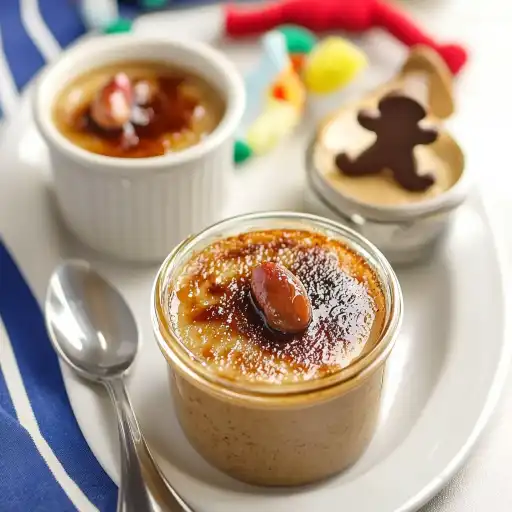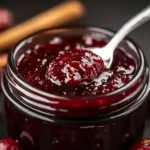Description of this recipe: This Gingerbread Crème Brûlée is a delightful twist on the classic French dessert, perfect for the holiday season or any time you crave a warm, spiced treat. Imagine the creamy, smooth texture of crème brûlée infused with the cozy flavors of gingerbread – cinnamon, ginger, cloves, and a hint of molasses. The crisp, crackling sugar crust provides a satisfying contrast to the rich custard below, creating a truly unforgettable dessert experience.
Why you will love this recipe: You will fall in love with this recipe for its simplicity and impressive flavor profile. It’s surprisingly easy to make at home, yet it delivers a restaurant-quality dessert that is sure to wow your family and friends. The warm spices evoke a sense of comfort and nostalgia, making it a perfect dessert for gatherings or cozy nights in. Plus, the act of torching the sugar crust is incredibly satisfying and adds a touch of theatrical flair to your dessert presentation.
Ingredients:
For The Custard:
- 2 cups heavy cream
- 5 tablespoons granulated sugar, divided
- 4 large egg yolks
- 1 tablespoon molasses
- 1 teaspoon vanilla bean paste or vanilla extract
- ¾ teaspoon ground cinnamon
- ¾ teaspoon ground ginger
- ½ teaspoon ground cloves
- ½ teaspoon ground nutmeg
- Pinch of kosher salt
For the Topping:
- ¼ cup granulated sugar
Preparation:
Step 1: Preheat your oven to 300 degrees Fahrenheit (150 degrees Celsius). This low temperature is crucial for ensuring a smooth, creamy custard. It prevents the eggs from curdling and allows the custard to cook gently and evenly.
Step 2: Prepare your baking dish and ramekins. Place four 1/2-pint mason jars or 6-ounce ramekins in a roasting pan. The ramekins will hold the custard during baking, and the roasting pan will act as a water bath to provide gentle, even heat.
Step 3: Bring a large kettle of water to a boil. The boiling water will be used to create a water bath, which helps to regulate the temperature and prevent the custard from overcooking.
Step 4: In a small saucepan, heat the heavy cream and 3 tablespoons of the granulated sugar over medium heat. Stir occasionally to prevent the sugar from scorching. Heat for 6 to 7 minutes, or until the cream just starts to bubble around the edges of the pan. It’s important to heat the cream to this point, as it helps to dissolve the sugar and infuse the cream with its flavor. Do not bring the cream to a full boil, as this can cause it to scald.
Step 5: While the cream is heating, prepare the egg yolk mixture. In a large bowl, whisk together the egg yolks, molasses, vanilla bean paste, cinnamon, ginger, cloves, nutmeg, salt, and the remaining 2 tablespoons of sugar. Whisk until the mixture is well combined and slightly pale in color. The molasses adds a depth of flavor and a touch of sweetness to the custard, while the spices provide a warm and aromatic gingerbread flavor.
Step 6: Temper the egg yolk mixture. This is a crucial step to prevent the eggs from curdling when they come into contact with the hot cream. While whisking constantly, use a ladle to slowly add 3 ladlefuls of the hot cream mixture to the egg yolk mixture. This gradual addition of heat allows the eggs to adjust to the temperature of the cream without cooking too quickly.
Step 7: Gradually whisk in the remaining cream mixture. Once the egg yolk mixture has been tempered, gradually whisk in the remaining hot cream mixture until everything is fully combined.
Step 8: Strain the custard mixture through a fine-mesh strainer into a large liquid measuring cup. This step helps to remove any lumps or impurities from the custard, resulting in a smoother, more refined texture.
Step 9: Divide the custard mixture evenly between the prepared ramekins. Pour the custard mixture carefully into each ramekin, filling them to about ¾ full.
Step 10: Place the roasting pan in the preheated oven. Carefully transfer the roasting pan with the ramekins to the oven.
Step 11: Add boiling water to the roasting pan. Pour enough boiling water into the roasting pan to come halfway up the sides of the ramekins. This water bath helps to regulate the temperature and ensure that the custard cooks evenly.
Step 12: Bake the custards for 35 to 40 minutes, or until they are just set. The custards should tremble slightly in the middle, but be set on the outer edges. To test for doneness, gently shake the roasting pan. If the custards jiggle slightly in the center but are firm around the edges, they are ready.
Step 13: Carefully transfer the ramekins to a cooling rack. Use tongs to carefully transfer the ramekins from the roasting pan to a cooling rack. Allow the custards to cool for 30 minutes at room temperature.
Step 14: Cover the ramekins with plastic wrap and chill for at least 4 hours, or up to 2 days before serving. Chilling the custards allows them to fully set and develop their flavor.
Step 15: To serve, sprinkle about 1 tablespoon of granulated sugar over each custard. The sugar will caramelize under the heat of the torch, creating a crisp, crackling crust.
Step 16: Using a blowtorch, caramelize the top of each custard until the sugar bubbles and turns golden brown. This can also be done under a broiler, but be sure to watch carefully to prevent burning. If using a broiler, place the ramekins on a baking sheet and broil for 1-2 minutes, or until the sugar is caramelized.
Step 17: Serve immediately and enjoy the symphony of creamy, spiced custard and crisp, caramelized sugar.
COOKING Rating: Intermediate
Serving Suggestions:
- Serve the Gingerbread Crème Brûlée as a standalone dessert for a sophisticated and satisfying treat.
- Pair it with a scoop of vanilla ice cream or a dollop of whipped cream for added richness.
- Garnish with a sprinkle of ground gingerbread spice or a dusting of cocoa powder for a festive touch.
- Serve with a cup of freshly brewed coffee or tea for a perfect after-dinner indulgence.
- For a more decadent experience, drizzle with caramel sauce or chocolate syrup.
Tips:
- Use high-quality ingredients for the best flavor.
- Don’t overbake the custards, as this can cause them to become rubbery.
- Be careful when using a blowtorch to caramelize the sugar. Keep the flame moving and avoid holding it in one spot for too long, as this can burn the sugar.
- If you don’t have a blowtorch, you can use a broiler to caramelize the sugar. Just be sure to watch carefully to prevent burning.
- For a smoother custard, strain the mixture through a fine-mesh sieve before baking.
- If you’re making the crème brûlée ahead of time, wait to caramelize the sugar until just before serving. This will ensure that the crust is crisp and crackling.
- Get creative with your flavor combinations! Try adding other spices, such as cardamom or star anise, to the custard. You can also experiment with different extracts, such as almond or rum.
Prep Time: 20 minutes
Cook Time: 35-40 minutes
Total Time: 4 hours 55 minutes (includes chilling time)
Nutritional Information: (per serving, approximate)
- Calories: 450
- Protein: 6g
- Sodium: 80mg
Conclusion:
This Gingerbread Crème Brûlée recipe offers a delightful twist on a classic dessert, bringing the warm and comforting flavors of gingerbread to a creamy, decadent treat. The combination of smooth custard, aromatic spices, and a crisp, caramelized sugar crust makes for an unforgettable culinary experience. Whether you’re looking to impress guests at a holiday gathering or simply want to indulge in a special dessert, this recipe is sure to satisfy your cravings and leave you wanting more. So gather your ingredients, follow the simple steps, and prepare to be transported to a world of sweet, spiced bliss. Enjoy!
Questions and Answers:
Q1: Can I make this recipe ahead of time?
A: Yes, you can absolutely make this recipe ahead of time. In fact, it’s recommended that you chill the custards for at least 4 hours, or even up to 2 days, before serving. This allows the flavors to fully develop and the custard to set properly. However, it’s best to wait to caramelize the sugar crust until just before serving, as the crust will lose its crispness over time.
Q2: I don’t have a blowtorch. Can I still make this recipe?
A: Yes, you can still make this recipe without a blowtorch. You can use a broiler to caramelize the sugar instead. Place the ramekins on a baking sheet and broil for 1-2 minutes, or until the sugar is melted and golden brown. Watch carefully to prevent burning.
Q3: Can I use a different type of milk instead of heavy cream?
A: While you can technically use a different type of milk, such as whole milk or half-and-half, the resulting custard will not be as rich and creamy. Heavy cream is essential for creating the signature texture of crème brûlée. If you’re looking for a lighter option, you can try using a combination of half-and-half and a small amount of heavy cream.
Q4: Can I add other flavors to this recipe?
A: Absolutely! This recipe is a great base for experimentation. You can try adding other spices, such as cardamom, star anise, or allspice, to the custard. You can also experiment with different extracts, such as almond, rum, or maple. Get creative and customize the recipe to your liking.
Q5: What is the best way to store leftover crème brûlée?
A: Leftover crème brûlée should be stored in the refrigerator, covered tightly with plastic wrap. It’s best to consume it within 2-3 days, as the custard may start to weep or lose its texture over time. If the sugar crust has already been caramelized, it will likely become soft and sticky in the refrigerator.




